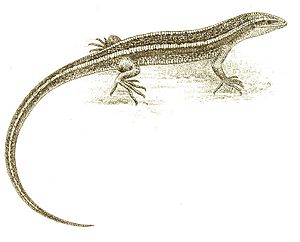New Zealand striped skink facts for kids
Quick facts for kids New Zealand striped skink |
|
|---|---|
 |
|
| Conservation status | |
| Scientific classification | |
| Genus: |
Oligosoma
|
| Species: |
striatum
|
The New Zealand striped skink (Oligosoma striatum) is a special kind of medium-sized skink. It is found only in New Zealand, which means it is endemic there. The scientific name striatum means "streaked," which describes its appearance.
These skinks usually live in native forests. You can often find them hiding under old, rotting logs in the bush. Sometimes, they are also found under logs left in fields after forests have been cleared. New Zealand striped skinks can also climb trees. They have been seen high up in the forest canopy, living among plants called epiphytes (plants that grow on other plants). They also live inside dead standing trees.
Contents
What is a Skink?
Skinks are a type of lizard. They usually have smooth, shiny scales and short legs. Some skinks don't have any legs at all! They are found all over the world, especially in warmer places. Skinks are often shy and like to hide.
Where Do They Live?
The New Zealand striped skink prefers to live in native forests. They like places where there are plenty of fallen logs and thick plants to hide in. These skinks are quite good at climbing. They can even live high up in trees, among other plants that grow on tree branches.
Conservation Status
The New Zealand striped skink is a rare animal. In 2012, the Department of Conservation in New Zealand looked at how many of these skinks were left. They decided the skink was At Risk. This means their numbers are going down, or are expected to go down.
Why is it At Risk?
Being At Risk means that there are fewer and fewer striped skinks. This might be because their homes (habitats) are being destroyed. It could also be because of predators like stoats or rats.
Other Classifications
The Department of Conservation also said the skink is Data Poor. This means scientists don't have enough information about them. It is also called Sparse, because they are spread out and not found in many places. Finally, it's Conservation Dependent. This means they need help from people to survive and thrive.


